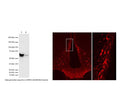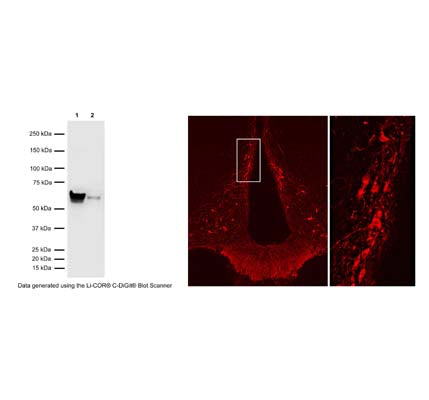Anti-Tyrosine Hydroxylase (TH) Antibody
Our Anti-Tyrosine Hydroxylase (TH) rabbit polyclonal primary antibody detects human and rat Tyrosine Hydroxylase (TH), and is affinity-purified. It is validated for use in IHC-Frozen, WB.


Left: Western Blot analysis of tyrosine hydroxylase (TH) expression in PC12 cell lysate (Lane 1: 6 ug) and mouse brain (Lane 2: 40 ug). The anti-TH rabbit antibody (1 µg/mL) detects one specific band at ~60 kDa corresponding to the expected molecular weight of TH in both samples. Method: SDS Page: denaturing and reducing, 4-12% Bis-Tris gel; Transfer: Tris-Glycine (Towbin's buffer) with 20% methanol; Membrane: PVDF (0.45 um); Blocking: 5% skim milk in TBST, 1 hr at RT; Primary antibody: R-148-50 (1 µg/mL), overnight at 2-8°C; Secondary antibody: donkey anti-rabbit (1:25,000), 1 hr at RT; Detection: Chemiluminescence. Right: Detection of TH-immunoreactivity in tuberoinfundibular dopaminergic neurons in rat hypothalamic arcuate nucleus by Immunohistochemistry. Primary antibody: rabbit anti-TH cat# R-148-50 (1:2,000); Secondary antibody: Cy3-conjugated anti-rabbit. Photo courtesy of Dr. Erik Hrabovszky, Hungarian Academy of Sciences, Budapest, Hungary.
Click on image to zoom
SKU: R-148-50
Ships: 1-2 business days
Product Details
Tyrosine Hydroxylase (TH)
Tyrosine hydroxylase (TH) is the rate-limiting enzyme in the synthesis of the catecholamines dopamine, epinephrine and norepinephrine. Therefore the regulation of the TH enzyme represents the central means for controlling the synthesis of these important catecholamines. FUNCTION: Plays an important role in the physiology of adrenergic neurons. CATALYTIC ACTIVITY: L-tyrosine + tetrahydrobiopterin + O2 = 3,4-dihydroxy-L-phenylalanine + 4a-hydroxytetrahydrobiopterin. COFACTOR: Fe(2+) ion. ENZYME REGULATION: Phosphorylation leads to an increase in the catalytic activity. PATHWAY: Catecholamine biosynthesis; first step. SUBUNIT: Homotetramer. PTM: In vitro, phosphorylation of Ser-19 increases the rate of Ser-40 phosphorylation, which results in enzyme opening and activation. SIMILARITY: Belongs to the biopterin-dependent aromatic amino acid hydroxylase family. The presence of different DNA sequences at the TH locus confers susceptibility to various disorders of the brain including manic-depression and schizophrenia. Parkinson's disease is also considered a TH deficiency as low dopamine levels are a consistent neurochemical abnormality.
Affinity-purified
Polyclonal
IgG
IHC, WB
Rabbit
60 kDa
A synthetic peptide (SPRFIGRRQSLIEDARK) as part of human Tyrosine Hydroxylase (aa: 32-47) conjugated to KLH
Human
Human, Rat
Spin vial briefly before opening. Reconstitute in 50 µL sterile-filtered, ultrapure water. Centrifuge to remove any insoluble material. After reconstitution keep aliquots at -20°C for a higher stability, and at 2-8°C with an appropriate antibacterial agent. Glycerol (1:1) may be added for an additional stability. Avoid repetitive freeze/thaw cycles.
Lyophilized
WB: 0.5-2 µg/mL
IHC: 0.5-1 µg/mL
IHC: 0.5-1 µg/mL
This antiserum has proven extremely useful for staining of catecholaminergic neurons, dendritic processes, and fine nerve terminals. This antibody demonstrates clear immunoreactivity for TH at 60 kDa in rat PC12 cell lysate and mouse brain homogenate.
Unconjugated
IHC on brain shows a pattern of staining specific for TH containing neurons. This antibody is known to react with rat. Cross reactivity with other species has not yet been tested.
For research use only.
United States
12 months after date of receipt (unopened vial).
Tyrosine hydroxylase; Tyrosine 3-monooxygenase; L-tyrosine hydroxylase; Tyrosine 3-hydroxylase;
25°C (ambient)


